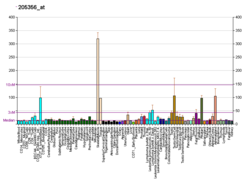| USP13 |
|---|
|
| Available structures |
|---|
| PDB | Ortholog search: PDBe RCSB |
|---|
| List of PDB id codes |
|---|
2L80, 2LBC |
|
|
| Identifiers |
|---|
| Aliases | USP13, ISOT3, IsoT-3, ubiquitin specific peptidase 13 (isopeptidase T-3), ubiquitin specific peptidase 13 |
|---|
| External IDs | OMIM: 603591; MGI: 1919857; HomoloGene: 68372; GeneCards: USP13; OMA:USP13 - orthologs |
|---|
| Gene location (Human) |
|---|
 | | Chr. | Chromosome 3 (human)[1] |
|---|
| | Band | 3q26.33 | Start | 179,653,032 bp[1] |
|---|
| End | 179,804,366 bp[1] |
|---|
|
| Gene location (Mouse) |
|---|
 | | Chr. | Chromosome 3 (mouse)[2] |
|---|
| | Band | 3|3 A3 | Start | 32,871,695 bp[2] |
|---|
| End | 32,992,220 bp[2] |
|---|
|
| RNA expression pattern |
|---|
| Bgee | | Human | Mouse (ortholog) |
|---|
| Top expressed in | - Skeletal muscle tissue of biceps brachii
- glutes
- thoracic diaphragm
- deltoid muscle
- vastus lateralis muscle
- tibialis anterior muscle
- triceps brachii muscle
- Skeletal muscle tissue of rectus abdominis
- right ventricle
- myocardium of left ventricle
|
| | Top expressed in | - interventricular septum
- muscle of thigh
- triceps brachii muscle
- temporal muscle
- sternocleidomastoid muscle
- digastric muscle
- soleus muscle
- myocardium of ventricle
- gastrocnemius muscle
- skeletal muscle tissue
|
| | More reference expression data |
|
|---|
| BioGPS |  | | More reference expression data |
|
|---|
|
| Gene ontology |
|---|
| Molecular function | - cysteine-type peptidase activity
- chaperone binding
- zinc ion binding
- BAT3 complex binding
- metal ion binding
- ubiquitin-like protein-specific protease activity
- proteasome binding
- peptidase activity
- ubiquitin binding
- protein binding
- ubiquitin-like protein ligase binding
- hydrolase activity
- ubiquitin protein ligase binding
- thiol-dependent deubiquitinase
- cysteine-type endopeptidase activity
| | Cellular component | | | Biological process | - regulation of transcription, DNA-templated
- ubiquitin-dependent protein catabolic process
- positive regulation of ERAD pathway
- proteolysis
- autophagy
- regulation of autophagy
- protein K63-linked deubiquitination
- maintenance of unfolded protein involved in ERAD pathway
- cell population proliferation
- melanocyte differentiation
- protein deubiquitination
- protein K29-linked deubiquitination
- protein K6-linked deubiquitination
- protein stabilization
| | Sources:Amigo / QuickGO |
|
| Orthologs |
|---|
| Species | Human | Mouse |
|---|
| Entrez | | |
|---|
| Ensembl | | |
|---|
| UniProt | | |
|---|
| RefSeq (mRNA) | | |
|---|
| RefSeq (protein) | | |
|---|
| Location (UCSC) | Chr 3: 179.65 – 179.8 Mb | Chr 3: 32.87 – 32.99 Mb |
|---|
| PubMed search | [3] | [4] |
|---|
|
| Wikidata |
| View/Edit Human | View/Edit Mouse |
|

















